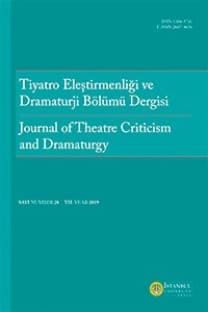Dog’s Day: Natural Folly and Subversion in Much Ado About Nothing*
This essay argues that Shakespeare’s natural fools, clowns, rustics, and buffoons provide far more than light comic relief. Using the example of Dogberry, from Much Ado About Nothing, I demonstrate that in allowing his fools to usurp their position of clownish caricature, to move outside of their normal social spheres, Shakespeare exposes the folly within societal institutions. Though an examination of language, namely the use of malapropisms, and the manipulation of traditional licence extended to natural fools, I contend that such theatrical depictions of folly opened the way for social commentary, parody and inversions of hierarchies of power on the stage.
Anahtar Kelimeler:
Shakespeare, Subversion, Folly, Clowns, Dogberry
Dog’s Day: Natural Folly and Subversion in Much Ado About Nothing*
This essay argues that Shakespeare’s natural fools, clowns, rustics, and buffoons provide far more than light comic relief. Using the example of Dogberry, from Much Ado About Nothing, I demonstrate that in allowing his fools to usurp their position of clownish caricature, to move outside of their normal social spheres, Shakespeare exposes the folly within societal institutions. Though an examination of language, namely the use of malapropisms, and the manipulation of traditional licence extended to natural fools, I contend that such theatrical depictions of folly opened the way for social commentary, parody and inversions of hierarchies of power on the stage.
Keywords:
Shakespeare, Subversion, Folly, Malapropism, Dogberry,
___
- Allen, John A., ‘Dogberry’, in Shakespeare Quarterly, Vol. 24, No. 1 (Winter, 1973), pp. 35-53. google scholar
- Armin, Robert, Nest of Ninnies (London: T.E. for John Deane, 1608). google scholar
- Bullough, Geoffrey, Narrative and Dramatic Sources of Shakespeare (London: Routledge and Kegan Paul, 1958). google scholar
- Duhaime, Lloyd, Duhaime’s Law Dictionary, Accessed 20 January 2021, h-t-tp://w-ww.duhaime.org/ LegalDictionary/N/NaturalFool.aspx. google scholar
- Erasmus, Desiderius, The Praise of Folly, translated by Hoyt Hopewell Hudson (New York: Random House, 1941). google scholar
- Foucault, Michel, Madness and Civilization: A History of Insanity in the Age of Reason (Abingdon: Routledge, 2001). google scholar
- Hazlitt, William, Characters of Shakespeare’s Plays (London: Oxford University Press, 1970). google scholar
- Hornback, Robert, The English Clown Tradition from the Middle Ages to Shakespeare (Cambridge: D. S. Brewer, 2009). google scholar h-t-tp://w-ww.thealexandrian.net/creations/shakespeare/Richard2-Woodstock-ASR-Script.pdf. google scholar
- Levin, Richard, The Multiple Plot in English Renaissance Drama (Chicago: University of Chicago Press, 1971). google scholar
- Lipscomb, Suzannah, ‘All the King’s Fools’, in History Today, Vol. 61, Issue 8 (August 2011). Accessed 20 January 2021, h-t-tp://w-ww.historytoday.com/suzannah-lipscomb/all-king’s-fools. google scholar
- Reimer, Marga, ‘What Malapropisms Mean: A Reply to Donald Davidson’, Erkenntnis, Vol. 60 (2004), pp. 317-334. google scholar
- Salkeld, Duncan, ‘Letting wonder seem familiar: Italy and London in Much Ado About Nothing’, in Much Ado About Nothing: A Critical Reader, eds. Deborah Cartmell and Peter J. Smith (London: Bloomsbury Arden, 2018), pp. 89-110. google scholar
- Shakespeare, William, The Oxford Shakespeare: The Complete Works, eds., Stanley Wells and Garry Taylor (New York: Oxford University Press, 2005). google scholar
- Smith, Peter J., Between Two Stools: Scatology and its Representations in English Literature, Chaucer to Swift (Manchester: Manchester University Press, 2012). google scholar
- Somerset, Alan, ‘Damnable Deconstructions: Vice Language in the Interlude’, Comparative Drama, Vol. 31, No. 4 (Winter, 1997), pp. 571-588. google scholar
- Thomas of Woodstock The Complete Readings of William Shakespeare, Editor Justin Alexander. Accessed 20 January 2021. google scholar http://w-ww.thealexandrian.net/creations/shakespeare/Richard2-Woodstock-ASR-Script.pdf. google scholar
- Wiles, David, Shakespeare’s Clown: Actor and Text in the Elizabethan Playhouse (Cambridge: Cambridge University Press, 1987). google scholar
- ISSN: 1303-8605
- Yayın Aralığı: Yılda 2 Sayı
- Başlangıç: 2002
- Yayıncı: İstanbul Üniversitesi
Sayıdaki Diğer Makaleler
Sevim Burak’s Protest Theatre: Understanding Sevim Burak Through Adorno
Sevgi Ayakları: “Uysal Özneler” Üzerinden Bir 12 Eylül Okuması
Türkiye’de Oyun Yazarlığında Yeni Eğilimler IV
Murat MAHMUTYAZICIOĞLU, Sami Berat MARÇALI
Dog’s Day: Natural Folly and Subversion in Much Ado About Nothing*
Aesthetics in Theatre: The Challenge of Effect Under the Skin
